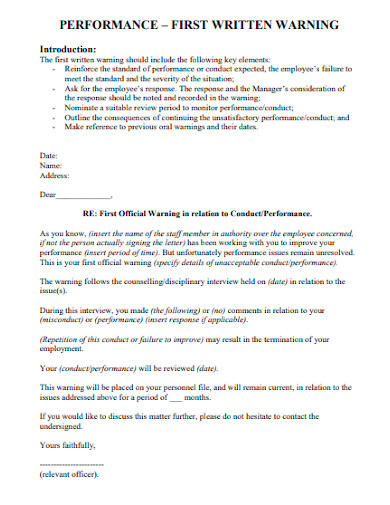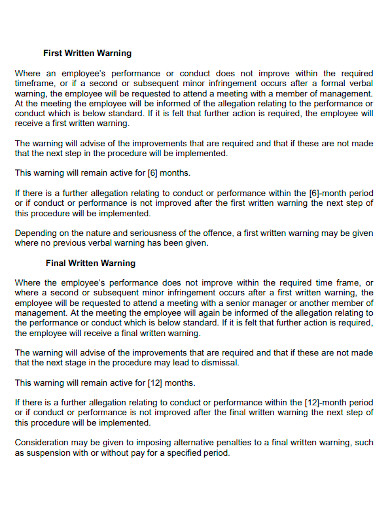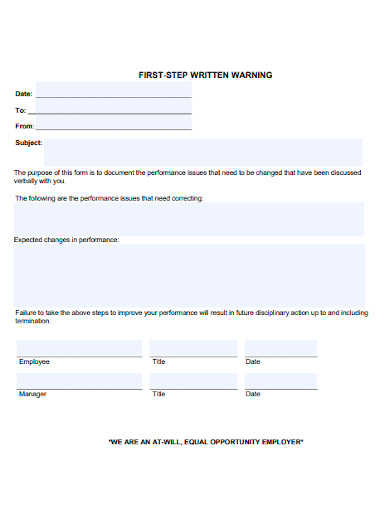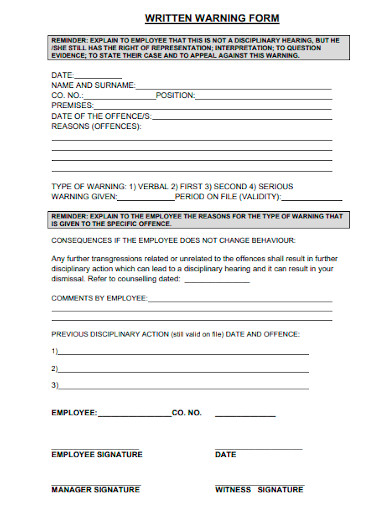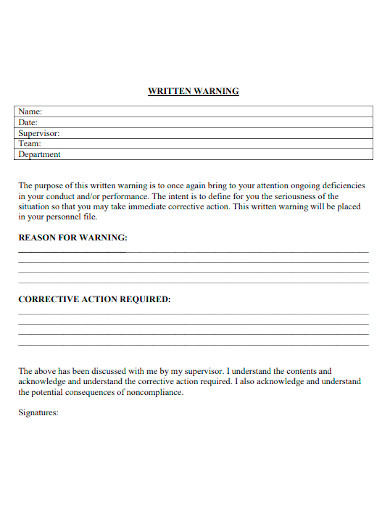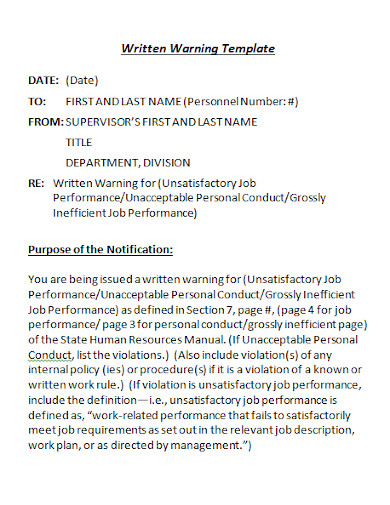There are various business firms and organizations which see the significance of supervision and providing support to their staff and employees in developing a solid framework for their professional identity and feel appreciated in their role. But if one or several employees suddenly or keeps on making some mistakes or issues inside the workplace, then the company or team supervisor should step up to provide them a notice of warning or a first written warning. In this article, we provide you some useful steps and a wide array of first written warning templates that you can easily use. Scroll until the end!
FREE 6+ First Written Warning Samples
1. First Written Warning Sample
2. Printable First Written Warning
3. First Step Written Warning
4. First Written Warning Form
5. Employee First Written Warning
6. Editable First Written Warning
7. First Written Warning Letter
What is a First Written Warning?
Basically, a first written warning is a written document which is designed for an employee or employees who have done a certain problem or conduct issue like having a poor work performance. It also serves as a reference to the employee’s work performance record.
How to Write a First Written Warning
If writing a formal written warning letter or an employee warning notice is not your cup of tea, don’t worry because we will help you in this matter. We recommend that you use our simple yet effective templates above that you can use conveniently. Here are the steps that you need to follow after you download your selected template:
1. Be specific and concise
Jacqueline Woodson reminds us that “The more specific we are, the more universal something can become. Life is in the details. If you generalize, it doesn’t resonate. The specificity of it is what resonates.” So, you need to write the terms, phrases, and sentences, especially you need to specify the issue in detail such as the dates, people involved, and the type of the offense.
2. Collect relevant information
You need to collect relevant information about the issue as much as possible which includes documents signed by the employee when he or she agreed to the terms and conditions of the company.
3. Provide a clear explanation
Include in your writing a clear explanation about the warning you’re issuing to the employee. State clearly the specific time duration that you will keep the warning on his or her file. Also, give details about the nature of the offense, incident or behavior while at the workplace. Inform the employee about your expectation on his improvement. Add the possible consequences if he or she further performs other wrong deeds.
4. Write in a logical manner
Most importantly, write everything that concerns you in a logical manner. End your warning notice or letter with some meaningful phrases that can catch the attention of your reader.
FAQ
Part of HR duties is to issue a warning letter to a specific employee. In this way, employers minimize legal risks when they fire an employee. So, a warning letter may also represent a disciplinary action to give warning to an employee regarding his or her violation of the company’s code of conduct.Is a warning letter a disciplinary action?
A disciplinary letter should include the specific date, time, and location. Plus, write the details of the allegations against the employee, proofs or documentation which clearly support the event, etc.What should a disciplinary letter include?
Providing an effective employee warning notice or letter of warning for an employee is possible if you first state the facts of the case clearly. Mention the specific issue concerning the employee. Then, invite the employee to a meeting to discuss the issue. Show the evidence that you have gathered. Hear his or her explanation or reason about their misconduct or poor work performance.How to write an effective written warning at work?
According to an article, there are five fair reasons for dismissal which are capability, conduct, redundancy, constructive, and other substantial reasons.What are the five fair reasons for dismissal?
The book “Successful Supervision and Leadership” stated that an effective supervision in workplaces should be implemented because it decreases professional fatigue, stress and burnout, as well as improving the employees’ skills and knowledge, and assisting them to be highly conscious of the intended outcomes in their role to prevent poor work performance or misconduct. Plus, one of the ways of effective supervision is providing a first written warning to certain employees in order to correct their wrongdoings at work. So, if you need to write a letter or notice to warn your employees, consider our guide and steps in this article. Download our warning notice samples right now!
Related Posts
FREE 9+ Sample Notice of Termination Letters
FREE 10+ Sample Employee Discipline Forms
FREE 16+ Sample Endorsement Letter Samples
FREE 16+ Payment Notice Samples
FREE 13+ Employee Warning Notice Samples
FREE 13+ Business Memo Templates
A Checklist: When Should You Fire an Employee [ With Samples ]
FREE Cover Letter for First Time Job Seekers
FREE Rules for Writing an Introduction Letter [ With Samples ]
FREE 7+ Sample Job Acceptance Letters
FREE 7+ Sample Formal Apology Letter Templates
FREE 7+ Introduction Letter to Clients Samples and Templates
FREE 10+ The Purpose of Employee Evaluation Samples
FREE 10+ School Disciplinary Action Form Samples
FREE Sample Termination Letter for the Workplace

